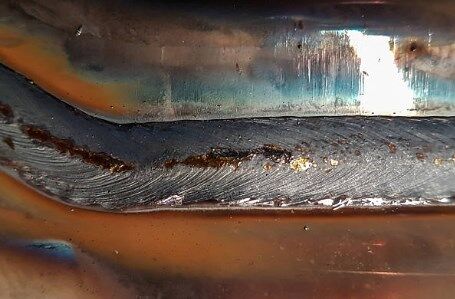Stainless steel is renowned for its exceptional corrosion resistance, a property that makes it a favorite in various industries. However, many welders encounter an unexpected issue: stainless steel rust after welding. This phenomenon seems contradictory, given stainless steel's reputation for durability. Understanding the reasons behind this rust formation and implementing preventive measures is crucial to maintaining the integrity and longevity of stainless steel welds.

Stainless Steel Rust after Welding
I. The Science Behind Stainless Steel
Stainless steel is an alloy primarily composed of iron, chromium (minimum 10.5%), and trace amounts of other elements like nickel, molybdenum, and manganese. Its corrosion resistance stems from a passive chromium oxide layer that forms on the surface, protecting the underlying metal from environmental factors. However, during welding, this protective layer can be disrupted, exposing the base metal to potential corrosion.
Key Properties of Stainless Steel:
II. Heat-Affected Zone (HAZ) and Chromium Depletion
Welding generates intense heat, which alters the microstructure of the material in the heat-affected zone (HAZ). This localized heating can lead to chromium depletion, as chromium migrates to the surface or oxidizes, weakening the passive layer.
Impact of High Temperatures:
The HAZ experiences a temporary loss of chromium, reducing corrosion resistance.
Austenitic stainless steels (e.g., 304, 316) are particularly susceptible to chromium depletion.
III. Oxygen and Contamination
After welding, the exposed stainless steel is vulnerable to oxygen and contaminants in the environment. Oxygen reacts with exposed iron atoms, initiating the rusting process. Additionally, contaminants like chlorides (from cleaning agents or handling) can accelerate corrosion.
Environmental Factors Contributing to Rust:
Moisture: High humidity or exposure to water accelerates oxidation.
Salts and Chlorides: These ions act as catalysts for corrosion.
Temperature: Elevated temperatures can speed up chemical reactions.
IV. Residual Stress and Microstructural Changes
The welding process induces residual stress and alters the microstructure of the stainless steel. These changes can create weak points in the material, promoting corrosion initiation. For instance, martensitic transformations in the HAZ can reduce ductility and increase susceptibility to rust.
Effects of Residual Stress:
Stress concentrations create pathways for corrosion.
Microstructural changes, such as precipitation of carbides, can further weaken the passive layer.
V. Preventive Measures and Solutions
Preventing rust on welded stainless steel requires a combination of proper welding practices, post-weld treatments, and environmental control. Below are some effective strategies:
1) Proper Shielding and Gas Protection
Use high-purity shielding gases (e.g., argon or helium) during welding to create an oxygen-free environment.
Ensure adequate gas flow rates to prevent atmospheric contamination.
2) Post-Weld Cleaning and Passivation
Clean the welded area: Remove slag, spatter, and contaminants using wire brushes, grinding, or chemical cleaning.
Passivation: Treat the surface with a chemical solution (e.g., citric acid or nitric acid) to restore the chromium oxide layer and reinstate corrosion resistance.
3) Controlled Heat Input and Welding Techniques
Optimize welding parameters to minimize the HAZ. Techniques like pulsed MIG welding or low-heat input processes reduce thermal damage.
Use cooling methods (e.g., forced air or water cooling) to limit temperature-related chromium depletion.
4) Environmental Control
Store or transport welded components in a dry, clean environment to reduce exposure to moisture and contaminants.
Apply a protective coating (e.g., wax or oil) to sensitive areas until the final assembly.
VI. Why Choose Megmeet Welding Technology?
Megmeet Welding Technology is a trusted name in the welding industry, offering high-quality equipment and solutions designed to address challenges like corrosion in stainless steel welding. With over 20 years of experience, Megmeet provides:
Advanced Welding Machines: Equipped with precise temperature control and shielding gas systems to minimize the HAZ.
Customized Welding Solutions: Tailored to meet the specific needs of your industry, whether it's automotive, construction, or shipbuilding.
Expert Technical Support: Our team is dedicated to helping you achieve flawless welds with maximum corrosion resistance.
VI. Conclusion
The occurrence of rust on stainless steel after welding is a complex issue influenced by heat, chromium depletion, and environmental factors. By implementing preventive measures like proper shielding, post-weld cleaning, and controlled heat input, you can effectively mitigate this problem. Megmeet Welding Technology is your partner in achieving high-quality, corrosion-resistant welds. Whether you're working on a small-scale project or an industrial application, we provide the tools and expertise to help you succeed.
If you have any questions or need further guidance on stainless steel welding, feel free to contact us. Let Megmeet Welding Technology be your trusted ally in the pursuit of perfection in welding.
Related Articles:
1. TIG Welding Stainless Steel: A Beginners Guide
2. How to Weld Stainless Steel Easily: 3 Common Methods Compared
3. How To MIG Weld Stainless Steel Like a Pro?
4. Stainless Steel Weld Cleaning: A Complete Guide to Methods & Techniques
5. How To Clean Stainless Steel Welds After Welding? [Easiest Way]




